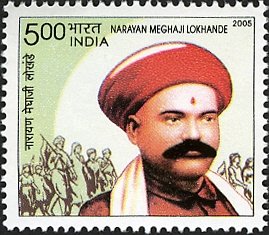Narayan Meghaji Lokhande (1848-1897)

Technical Data
| Date of Issue | May 3, 2005 |
|---|---|
| Denomination | Rs. 5 |
| Quantity | 400,000 |
| Perforation | comb 14 |
| Printer | Security Printing Press, Nashik |
| Watermark | No Watermark |
| Colors | Multicolor |
| Catalog Codes |
Michel IN 2089 Stamp Number IN 2106 Stanley Gibbons IN 1854 Stanley Gibbons IN 2273 WADP Numbering System - WNS IN020.05 |
| Themes | Commemoration | Famous people | Headgear | Labour Organisations | Men | Politicians |
Table of Contents
Commemorative Stamp Set: “Narayan Meghaji Lokhande (1848-1897)”
Design Elements
Visuals:
- Stamp 1: A portrait of Narayan Meghaji Lokhande, depicting him in traditional attire, emphasizing his dignified and resolute appearance as a leader of the working class.
- Stamp 2: An image of workers in a textile mill, symbolizing the factory setting where Lokhande organized labor and led movements to improve workers’ rights.
- Stamp 3: A scene of Lokhande addressing a gathering of workers, capturing his role as a pioneering labor leader and his efforts in uniting workers to fight for their rights.
- Stamp 4: A collage showing a factory building with a clock, referencing the historic moment when workers’ hours were reduced, alongside a depiction of factory workers reading the “Dinbandhu” newspaper, which Lokhande was instrumental in editing.
- Miniature Sheet: A depiction of key achievements, including images of workers, the Dinbandhu newspaper, and a clock set to an 8-hour day, symbolizing Lokhande’s role in advocating for an 8-hour workday.
Color Palette:
- Earthy browns, dark greens, and greys to represent the factory environment.
- Deep red and gold tones to convey strength, unity, and the valor of the working class.
Text Elements:
- Each stamp to include: “Narayan Meghaji Lokhande, 1848-1897,” along with key words like “Pioneer,” “Labor Rights,” and “Workers’ Unity.”
Cultural and Historical Significance
Narayan Meghaji Lokhande is widely regarded as one of the earliest labor leaders in India. Often referred to as the “Father of the Indian Labour Movement,” Lokhande was instrumental in advocating for workers’ rights in the late 19th century. He worked tirelessly to improve working conditions, reduce work hours, and establish weekly holidays for mill workers in Bombay (now Mumbai). His work laid the foundation for organized labor movements in India, and he played a crucial role in getting workers’ demands recognized by mill owners. Lokhande also edited the first labor-focused newspaper, “Dinbandhu,” which raised awareness about workers’ issues.
Usage
These stamps can be used for:
- Postage: Celebrating Narayan Meghaji Lokhande’s contributions by making his legacy known through regular mailing services.
- Commemorative Collectibles: Popular among philatelists and those interested in the history of labor rights in India.
- Educational Tools: In schools, trade unions, and historical exhibits to educate about the origins of the labor movement and the importance of workers’ rights.
Importance of the Commemorative Stamp Set
This stamp set honors Narayan Meghaji Lokhande’s pioneering efforts as a labor leader. His work in the late 19th century laid the groundwork for organized labor in India, advocating for better working conditions and fair treatment. Recognizing his contributions through this commemorative set brings attention to the importance of labor rights, solidarity, and the history of social reform movements.
Example of the Stamp Design
- A stamp featuring Lokhande’s portrait with a backdrop of a factory and workers, highlighting his efforts to unify and uplift the working class.
- Another stamp showing a factory setting, with a clock set to 8 hours and workers leaving for the day, symbolizing the success of his campaign for a shorter workday.
Significance
The commemorative stamp set emphasizes Lokhande’s contribution to the labor movement in India, inspiring recognition of the value of fair working conditions and organized labor. It serves as a reminder of the struggle for workers’ rights, a legacy that continues to resonate in modern labor policies and trade union activities.
